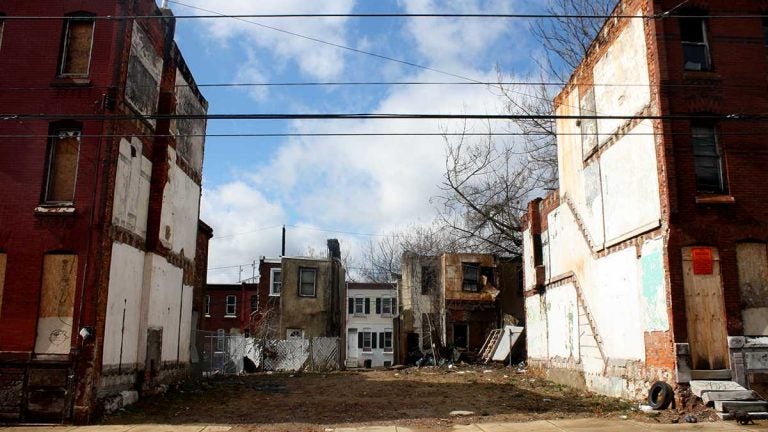‘Greening’ vacant lots improves mental health in Philly communities
The study adds to a growing body of research that demonstrates how where you live matters for your health.

A vacant North Philadelphia lot. (Jared Brey/PlanPhilly, file)
Vacant and dilapidated lots are a common city eyesore — not just in Philadelphia, but across the country. About 15 percent of urban land across the U.S. is either vacant or abandoned. And that blight not only affects a neighborhood’s appearance; it also attracts crime and makes people living in those neighborhoods feel unsafe and depressed.
But a new study by University of Pennsylvania researchers finds that something as simple as planting grass seed and a few trees can improve a community’s mental health.
The study looked at more than 500 vacant lots across Philadelphia and divided them into three groups.
One group got a green makeover: The Pennsylvania Horticultural Society removed trash; graded the land; sowed grass seed and planted a few trees; added a low wooden fence; and maintained the property once the work was complete.
The second group received a trash cleanup, limited grass mowing, and maintenance. And the third group was the control; those lots weren’t touched.
Researchers interviewed members of the community living near the blighted lots before and after the interventions. They found that people living near newly “green” vacant lots reported a reduction in feelings of depression and worthlessness.
The finding was even more pronounced when looking at neighborhoods below the poverty line where the residents’ feelings of depression decreased by 68 percent. Overall, nearly half of the those interviewed made less than $25,000 per year, and about a quarter made less than $10,000.
There was no improvement in the mental health of people living near lots where trash was cleaned up or nothing at all was done.
Linking green space, better mental health
“This is the first time that we actually have experimental evidence that putting new green space into neighborhoods can have an impact on mental health,” said Eugenia South, assistant professor of emergency medicine at the University of Pennsylvania and lead author of the study.
“Green space is important for health,” she said. “It’s not just important because it looks nice, but it actually can have an impact on health, particularly for low-resource communities who don’t have a lot of green space in them already.”
The mechanism by which green space improves mental health is likely multifaceted. For one, green outdoor spaces improve social connection among people in the community. It gives people a place to gather and interact, and that, in turn, leads to better mental health.
Green space has also been shown to help people recover from mental fatigue, which results from the exposure to noise and stimuli that people encounter in their everyday lives, especially in cities.
The authors noted that greening vacant spaces is a relatively low-cost intervention. By their estimates, it cost approximately $1,597 per vacant lot and $180 per year to maintain.
“This is very scalable and reproducible for cities who are interested in these types of environmental improvements,” South said.
The study adds to a growing body of research that demonstrates how where you live matters for your health. In earlier research, the authors had shown that greening blighted spaces could be a cost-effective way to combat gun violence, in addition to reducing fear in the community. Numerous other studies have shown neighborhood characteristics can have a significant impact on health.
A key for urban planners
This latest study had a few limitations. The mental health data from community residents was self-reported, and researchers didn’t use the Diagnostic and Statistical Manual of Mental Disorders to diagnose depression, so it is unknown if actual diagnoses of depression decreased. Researchers also stopped following participants after 18 months, so they couldn’t say whether the effects on mental health would last.
Nevertheless, supporters of urban green space said the results are compelling and should be taken seriously by those involved in urban planning.
“Planners know that your ZIP code is your destiny,” said Larry Wiseman, senior adviser to the Sustainable Urban Forest Coalition and former chair of the National Urban and Community Forestry Advisory Council. “And this goes for trees too. Equity means that the environmental benefits trees bring — better health, for one thing — should be available to all residents, no matter their income level.”
South and her team also secured extra funding to make sure the two groups of vacant lots that didn’t get the green treatment were able to have the same greening process once the study was complete.
WHYY is your source for fact-based, in-depth journalism and information. As a nonprofit organization, we rely on financial support from readers like you. Please give today.





